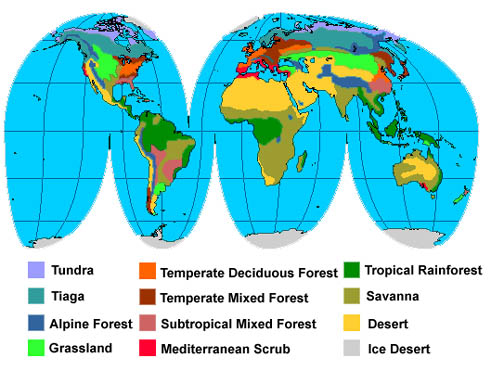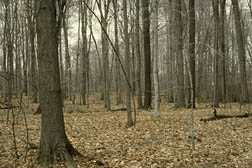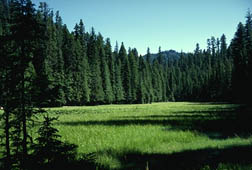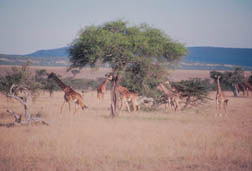© Copyright 2002 by Paul Ramp. All rights reserved.
Chapter 42: Biomes
Objectives:
- understand the use of the term biome
- describe and be alble to identify the locations of the biomes discussed
From this unit you should be able to:
Web Text:
Biomes - Biomes are large geographic regions on the earth that are characterized by certain climatic conditions. Because the climatic conditions within a biome are similar, one finds that general types of vegetation and animals within a biome are also similar.
Exactly how many biomes there are on earth depends on the individual that is describing them. So prefer to have more narrow definitions of each biome and consequently recognize a greater number on earth. Other chose broader definitions of biomes, lumping several together and recognizing fewer. Besides personal preferences, the demands of the immediate question one is working with may also influence how broad or narrow one defines a biomes. The result of this is that if one picks up two different text books, one is likely to find somewhat different representation of the earth's biomes.
Here is a map showing one representation of the biomes on earth. Fewer or more could be mapped by combining or splitting the areas shown.

| As indicated earlier, the two primary determinants of climate are the temperature conditions and the amount of precipitation. Instead of mapping the biomes on a geographic map, one could also map these on a graph having precipitation on one axis and temperature on another. If we do this, the biomes could be charted as shown here. |  |
While not attempting to cover all of these, here we will discuss the characteristics of several biomes.
Tropical Rainforest - The tropical rainforest is perhaps the most complex ecological system on earth. The regions of the tropical rainforests are characterized by having a mean annual temperature above 75 degrees F and are frost free. Typically a tropical rainforest will receive over 2 meters of precipitation annually with no less than 100 mm (approximately 7 inches) in any month.
|
These biomes are generally found between the Tropic of Cancer and the Tropic of Capricorn, below elevations of 1,300 meters. The three largest expanses of tropical rain forest occur in Central and South America, in the Congo, Niger and Zambezi River basins of Africa and in Southeast Asia. This represents approximately 12% of the earth's surface. One of the features the tropical rainforests have long been noted for is their enormous species richness. Its been estimated that fully 75% of all species on earth make their home in the tropical rainforest. For example, the rain forest of Madagascar contains over 2,000 tree species, in all of North America there are about 600 tree species. About 20% of all bird species occur in the Amazon and another 16% are found in the rainforests of Indonesia. The Amazon river holds 2,000 species of fish, 10 times the number of fish species found in all of Europe. |
 |
The plant communities of the tropical rainforests are typically evergreen forests, never having a season without leaves. The structure of the plant community is quite complex. Various species grow to different heights in the forest creating several layers of vegetation. These multiple layers of vegetation create numerous microhabitats that support the enormous animal diversity. Some animals live in the canopy, never coming down while on the wet forest floor, the habitat is ideal for amphibians.
Temperate Deciduous Forest - One of the larger regions of temperate deciduous forests is found in North America basically east of the Mississippi River. Other large tracts of temperate deciduous forest are found in eastern Asia and western Europe. It is characterized by a moderately humid, continental climate. The summers are warm to hot with relatively high rainfall. Winters are severe with freezing temperatures at least part of the time. The growing season in the temperate deciduous forest is usually between 4 to 8 months.
|
The vegetation is dominated by deciduous (loose their leaves seasonally), broad-leaved trees. The diversity of tree species is rich in most places but some areas that were glaciated during the last ice age are notably less species rich. Common trees found in temperate deciduous forests include species of oak, maple and hickory. Some of the larger animals found in these areas include the white tailed deer and the black bear. You will also find a good diversity of ground dwelling rodents as well as some tree dwelling animals. |
 |
Temperate Grassland - The temperate grasslands are characterized by warm to hot summers and cool to cold winters. Precipitation is variable but usually less that 60 cm. Periodic droughts are common. The quantity of precipitation is generally insufficient to support broad-leaved trees.
|
In areas that receive greater quantities of precipitation, the grassland is characterized by tall growing grass species, some growing as tall as 2 meters. We find this vegetation in the tall grass prairies of the eastern plain states of the United States. Areas where precipitation is less, the grassland in characterized by species of shorter stature as we find in the short grass prairies of the western plain states of the United States. The animals of the grasslands are characterized by large herds of grazing ungulates although the diversity of species is much less than found in the savannas. One also will find a number of burrowing species in the grasslands. |
 |
Taiga - The taiga is also known as the boreal forest. This biomes spans across northern North America from the Pacific to the Atlantic and across northern Europe and Asia from the Atlantic to the Pacific. The climate of this biome is characterized by short, cool summers and long severe winters. Most of the precipitation occurs during the summer months. In part due to the cold conditions, the soils of the taiga are usually high in organic acids and often minerally deficient.
|
The vegetation is dominated by needle-leaved species of trees. Most of these species are evergreen, keeping their leaves throughout the winter. This forest is less species rich than that of the temperate deciduous forest. Typically one finds species of pines, spruces and furs. Ferns, mosses, lichens and dwarf shrubs are the common species of the forest floor. Large animals of this biome include the moose, wolverine, lynx and hares. One also finds many invertebrates such as mosquitoes and blackflies that have short but intense life cycles |
 |
Tundra - The tundra is characterized by long cold winter and very short cool summers. The growing season in the tundra is usually less than 90 days. Annual precipitation is quite low in the arctic tundra (higher in alpine tundra). A key characteristic of the tundra is that below a certain depth, the soil is permanently frozen (permafrost).
The vegetation of the tundra is characterized by the absence of trees. Most of the vegetation is low growing grasses and sedges as well as some low growing shrubs such as heaths. Lichens are common. You will find widely scattered predators in the tundra, usually near the coastal areas as well as more invertebrates with their intense short life cycles.
